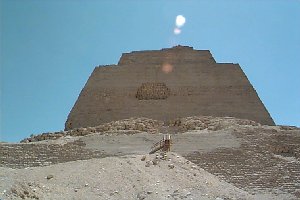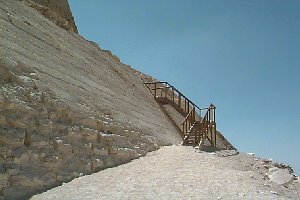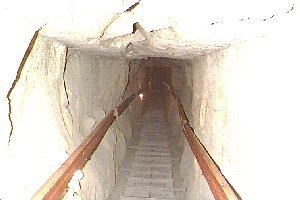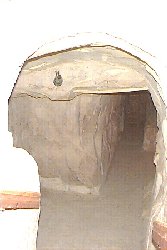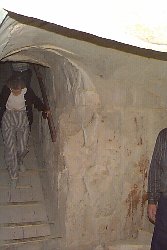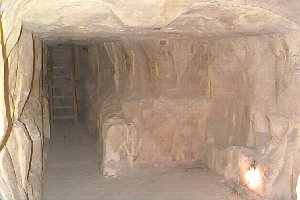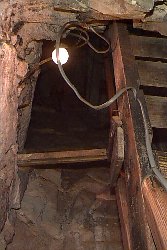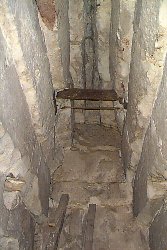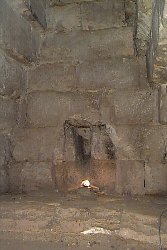|
|
|
|
|
Beginning with this pyramid we begin to see all of the components of a typical pyramid complex. New features include components that would also become standard in successive pyramid complexes. First, we see the introduction of the causeway, a pathway leading from a Chapel on the east face to a valley temple. It appears that the causeway had walls made of limestone. |
On the north face is the entrance. The original casing can be
seen as we walk up the sand ramp to the steps which were installed in modern times to
enter the pyramid: |
|
|
Part way down the lining of the passageway becomes very roughly hewn and
no longer is smooth and neat. We finally get to the bottom and enter the first
antechamber: In antiquity the entrance to all pyramids were concealed, usually ingeniously
covered by casing stones which were indistiguishable from other parts of the casing. Long
since the entrance has been found and is currently protected by metal doors which are kept
locked. As the doors are opened you can see down into the descending passageway which
ultimately leads to the burial chamber. One can almost fully stand straight in this
passageway unlike the descending passageways of later pyramids. At first the lining of the
passageway is smooth and evenly cut: |
|
Part way down the lining of the passageway becomes very roughly hewn and
no longer is smooth and neat. We finally get to the bottom and enter the antechamber: |
|
When you enter the antechamber and turn around you can see the vaulted
ceiling leading back up the passageway. The antechamber is also roughly hewn, and there is
a niche-like shelf to the right side. Through another short passageway you can see the the
ladder that leads to the main burial chamber. As you climb up the ladder the temperature
rises slightly: |
|
As you enter the main chamber you can see the first traces of a
corbelled roof inside a pyramid. At points in the ceiling you can see the remnants of wood
over 5000 years old straddling the upper courses. Perhaps this was used to lower the lid
onto the sarcophagus and also for the workers to climb in and out of the chamber.
Ironically, if the pyramid was ever used it could have also been used by the very looters
that plundered the burial. The cut of the courses in the corbelling is rough, yet it it
still has an thrilling impact when you first see this. The floor bears traces of a space
that was possibly once occupied by a sarcophagus, but it is not certain that this pyramid
was ever completed or that any king was ever buried here: |
|
You have visited the interior of the first "true" pyramid. Perhaps started as a step pyramid, this pyramid was the first one known in Egypt to have had the steps filled in to create a smooth true pyramid. It appears from the exterior as though the steps themselves may have been covered with a smooth outer casing which may either explain its collapse or the ease in which the casing was stripped away and quarried as building materials in later structures. We now move on to the next step in the evolution of the Egyptian pyramid, visiting the two pyramids of Sneferu at the recently re-opened site of Dahshur. |
|

